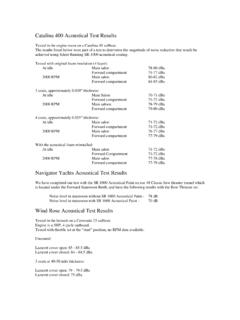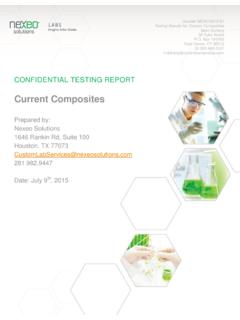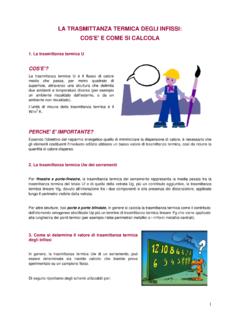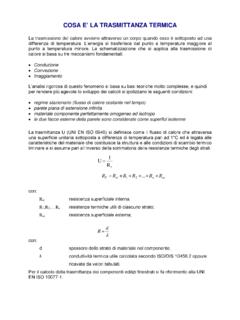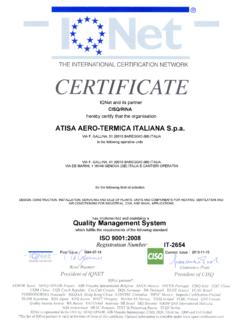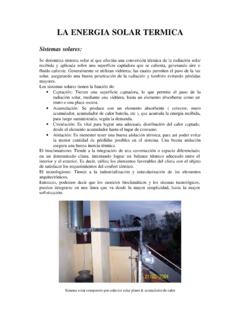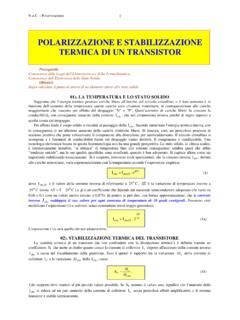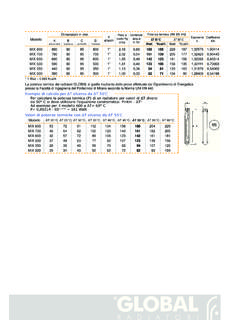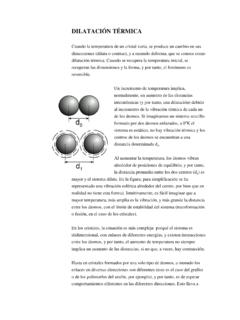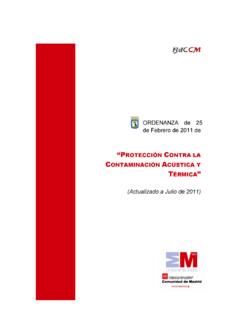Transcription of Center for Composite Materials - Silent Running
1 Center for Composite Materials . | 201 Composites Manufacturing Science Lab | University of Delaware | Newark, DE 19716-3144 phone: (302) 831-8149 | | fax: (302) 831-8525 Thermal Analysis of Silent Running Acoustic Barrier material By: Dr. J. Tierney, Prof. J. W. Gillespie Jr. INTRODUCTION In this work, the thermal properties of a Silent Running acoustic material are found at room temperature and 200 F using ASTM E1461-01, Standard test method for Thermal Diffusivity by the Flash Method. This test can be used to determine thermal diffusivities ranging from 10-7 to 10-3 m2/s at temperature ranges from 75-2800K, thermal conductivity and specific heat (using known reference material ). The equipment used is a NETZSCH Nanoflash LFA447 which can analyze up to four samples under independent thermal conditions (or three samples with reference material ) TEST DETAILS A small, thin disc specimen is subjected to a high intensity short duration radiant energy pulse.
2 The energy of the pulse is absorbed on the front surface of the specimen and the resulting rear face temperature rise (thermogram) is recorded. The thermal diffusivity value is calculated from the specimen thickness and the time required for the rear face temperature rise to reach certain percentages of its maximum value. When the thermal diffusivity of the sample is to be determined over a temperature range, the measurement must be repeated at each temperature of interest. In principle, the thermal diffusivity is obtained from the thickness of the sample and from a characteristic time function describing the propagation of heat from the front surface of the sample to its back surface. The sources of uncertainties in the measurement are associated with the sample itself, the temperature measurements, the performance of the detector and of the data acquisition system, the data analysis and more specifically the finite pulse time effect, the nonuniform heating of the sample and the radiative heat losses.
3 These sources of uncertainty can be considered systematic, and should be carefully considered for each experiment. Errors random in nature (noise, for example) can be best estimated by performing a large number of repeat experiments and comparing their results. The relative standard deviation of the obtained results is a good representation of the random component of the uncertainty associated with the measurement. Sample Preparation The samples were bored using a hollow bit, cleaned and polished on both sides with an SBT Model 920 lapping and polishing machine and finally machined to 1mm thickness to match the thickness of the reference material (for specific heat measurements). The reference material in this study was a 1mm think diameter Polyimide (Vespel) material which has a similar thermal conductivity to the material being investigated.
4 A gold layer was sputtered on the surface of this transparent reference material to make it opaque. The material investigated did not require a coating to prevent radiation being transmitted through the sample. All samples were measured and coated with a graphite lubricant to appear uniformly black (emissivity = ) and placed in the sample holder (Figure 1) Figure 1. Sample holder used for Nanoflash experiments Using the Nanoflash Measurement software, the same pulse type, and filter settings were applied to all three samples and reference material . The LFA Analysis software used to create a new database to store the voltage readings from the LF detector. In-range optimal data capture was carried out by varying the gain to minimize the signal to noise ratio from the resulting data.
5 The thermal diffusivity was found using ASTM Standard E1461 with a Cowan cooling curve correction factor included. With a known density and reference sample specific heat the specific heat capacity and thermal conductivity can also be found. Results Table 1 and 2 are the raw results and summary for the room temperature and 200 F results. 5 shots were taken for each sample. The density of the material was found to be by measuring the volume and mass of a number of fixed core samples. The R-values (R = d/k) are also given for a measured thickness of supplied material of Also shown are the more common English units for this material . Table 1. Room Temperature Thermal Properties ROOM TEMPERATURE Thickness = Shot No.
6 C Diffusivity/(mm^2/s)K/(W/(m*K)) Cp/(J/g/K)R Value* (Km^2/W) R Value* (ft^2 h/Btu) 1 #Mean #Std_Dev Shot No. C Diffusivity/(mm^2/s)K/(W/(m*K)) Cp/(J/g/K)R Value* (Km^2/W) R Value* (ft^2 h/Btu) 1 25 25 #Mean 25 #Std_Dev Shot No.
7 C Diffusivity/(mm^2/s)K/(W/(m*K)) Cp/(J/g/K)R Value* (Km^2/W) R Value* (ft^2 h/Btu) 1 #Mean #Std_Dev Diffusivity/(mm^2/s)K/(W/(m*K)) Cp/(J/g/K)R Value* (Km^2/W) R Value* (ft^2 h/Btu) Summary Average STD COV *R-values based on measured thickness of Table 2. Thermal Properties at 200 F 200F TEMPERATURE Shot No.
8 C Diffusivity/(mm^2/s) K/(W/(m*K)) Cp/(J/g/K)R Value* (Km^2/W) R Value* (ft^2 h/Btu) 1 #Mean #Std_Dev 0 Shot No. C Diffusivity/(mm^2/s) K/(W/(m*K)) Cp/(J/g/K)R Value* (Km^2/W) R Value* (ft^2 h/Btu) 1 #Mean #Std_Dev 0 Shot No.
9 C Diffusivity/(mm^2/s) K/(W/(m*K)) Cp/(J/g/K)R Value* (Km^2/W) R Value* (ft^2 h/Btu) 1 #Mean #Std_Dev 0 Diffusivity/(mm^2/s) Conductivity/(W/(m*K))Cp/(J/g/K)R Value* (Km^2/W) R Value* (ft^2 h/Btu) Summary Average STD COV *R-values based on measured thickness of

